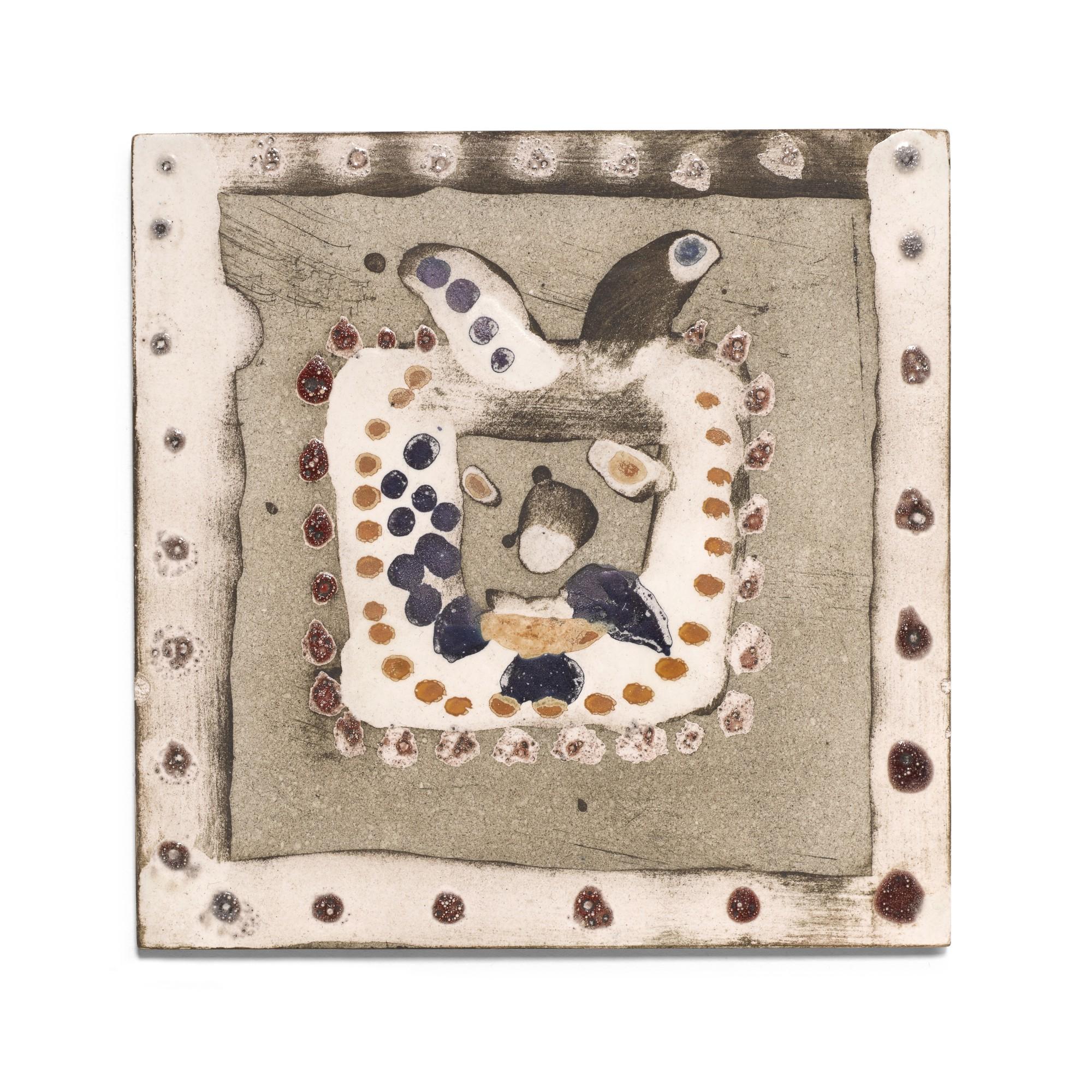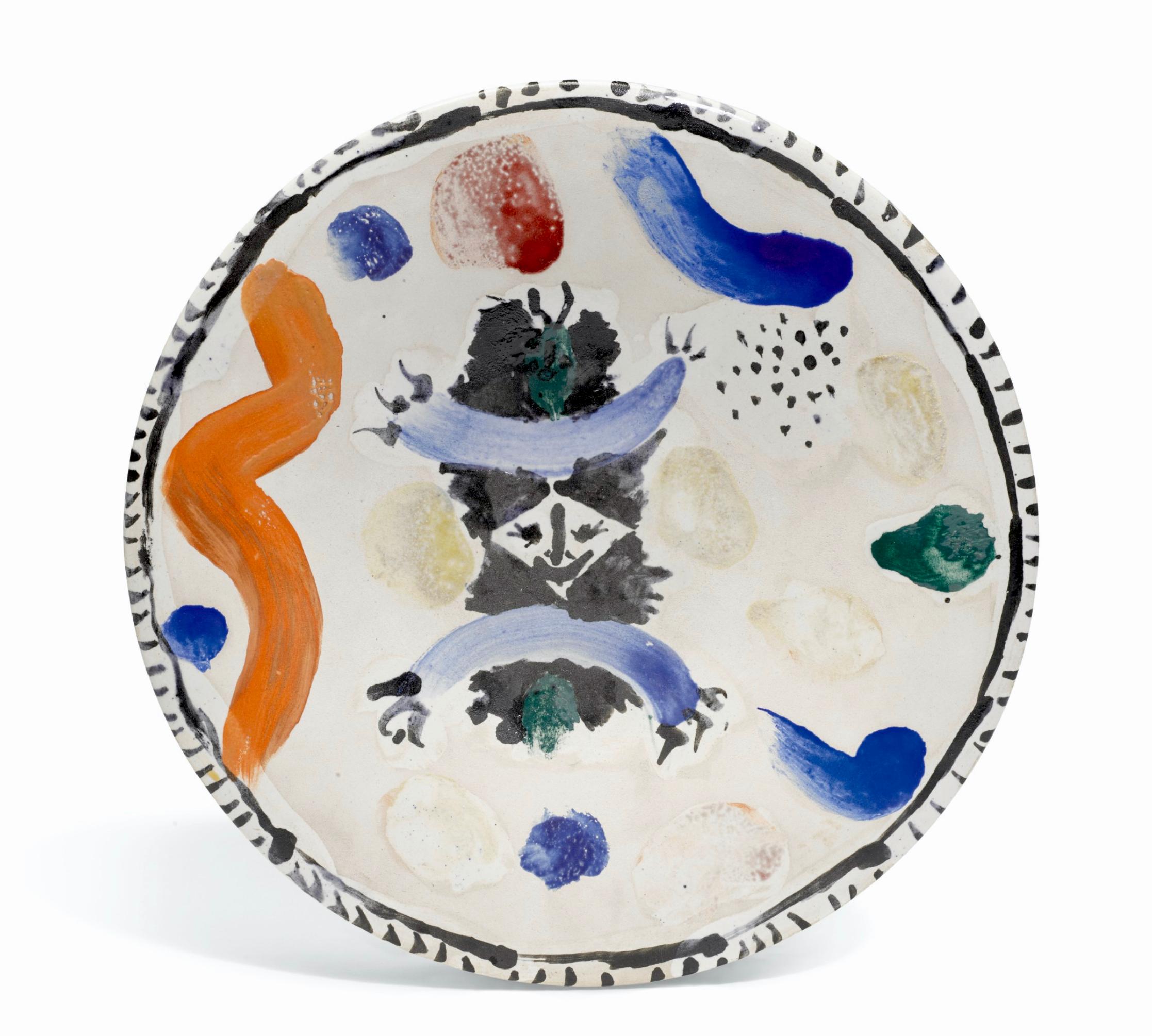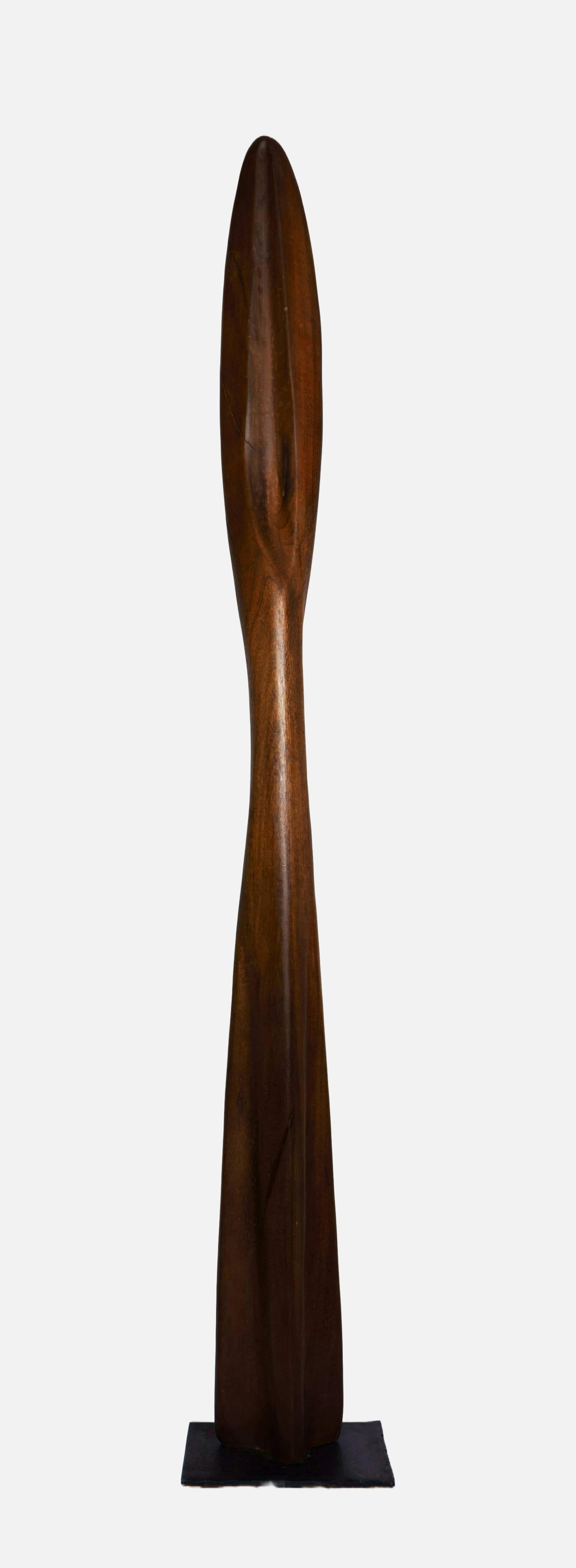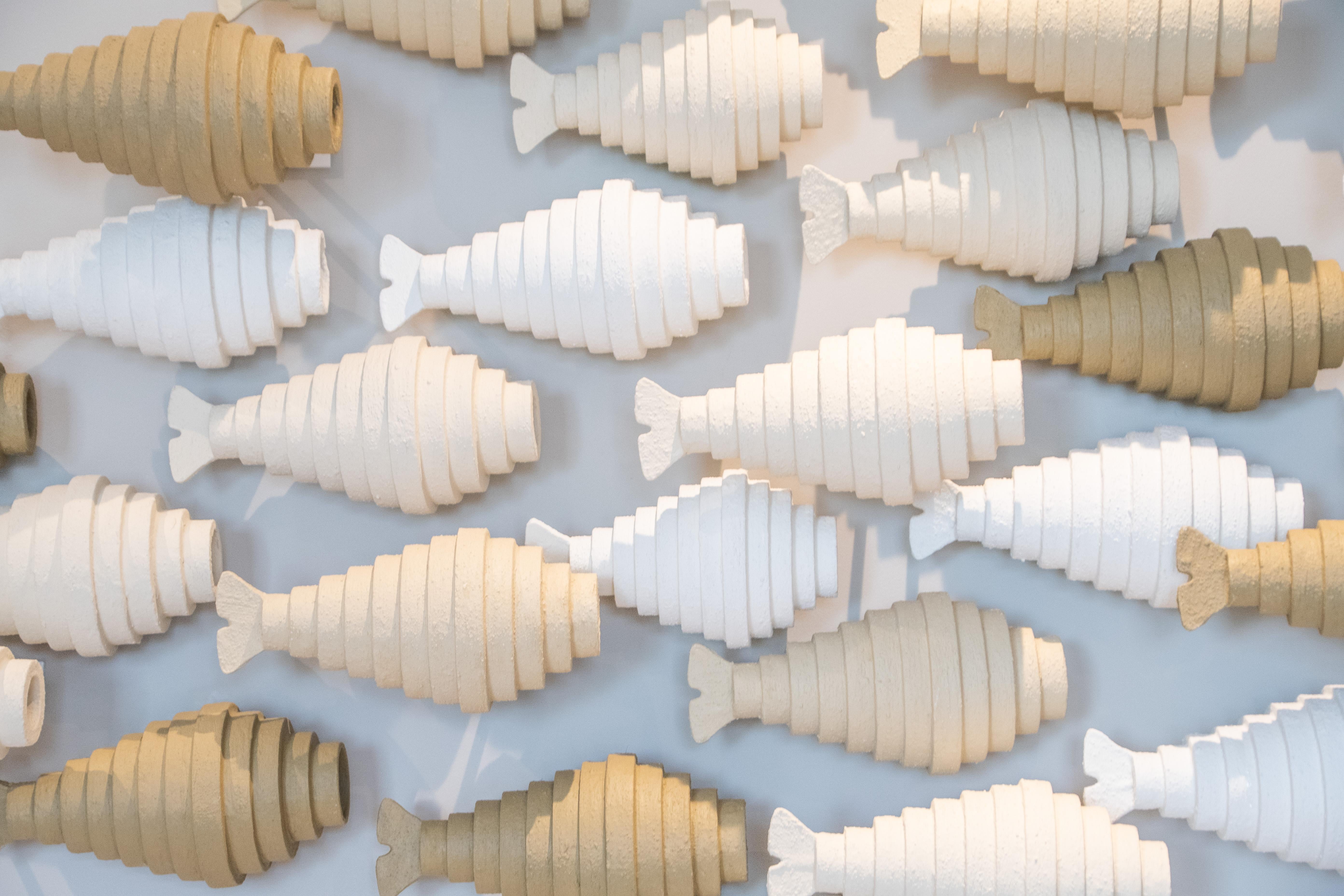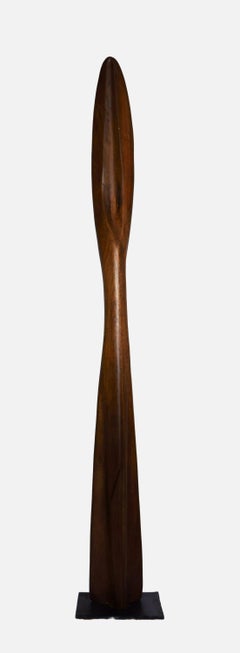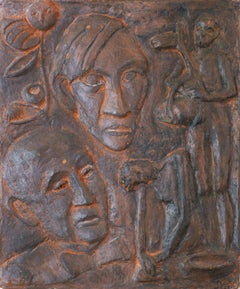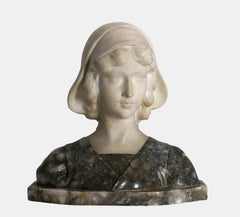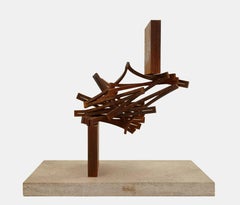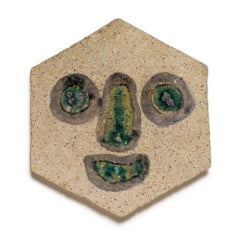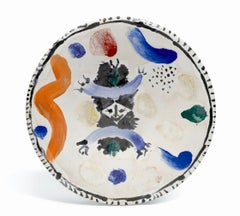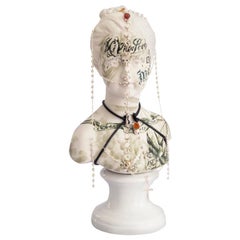Items Similar to Archaic Head / - Shaped Originality -
Want more images or videos?
Request additional images or videos from the seller
1 of 11
Paul DierkesArchaic Head / - Shaped Originality -1952
1952
About the Item
Paul Dierkes (1907 Cloppenburg - 1968 Berlin), Archaic Head. Limestone, 1952. 15 x 9 x 12 cm (without plinth), 19 x 10 x 11 cm (with plinth), monogrammed "PD" on the reverse.
- Shaped Originality -
At first glance, the limestone sculpture is recognizable as a human head, although it does not have a fully formed face. The nose, eyes, and ears are only hinted at, and yet they are so present that we immediately recognize them as features of a head, and we identify the bulge above the nose as the forehead, and the area below as the chin and neck, and we think we see the mouth and eyebrows, although they are not even hinted at.
We are looking at a kind of prototype of the head, although the head itself does not have the shape of a human head as it exists in nature. Nor is it the geometric shape of a circle or an oval, which would have an original and at the same time timeless character. Rather, we see a form shaped by a creator that cannot be resolved geometrically, although - especially when viewed from the side - it has a geometric rigor similar to that of Oskar Schlemmer's heads. Unlike Schlemmer's figures, however, Dierke's work reveals itself as something created: Traces of the shaving iron and the blows of the chisel are visible everywhere. The head is a handcrafted work of art that looks like an archaic artifact. The impression of originality therefore applies to both the representation and the production: the face only indicated goes beyond any concretely formulated physiognomy, so that a "primal individuality" reminiscent of the figures on Easter Island can be seen here, which appears to have been created with primitive tools by an original creative will.
The impression of originality is reinforced by the ancient material of the stone, on which the traces of carving are also perceived as traces of weathering, making the head appear like a mysterious archaeological artifact that reveals ever new aspects depending on how it is turned and how the light falls. The wooden base, which also presents its own material and on which the head rests freely, fits in with this.
About the arist
As the son of a stonemason, Paul Dierkes was familiar with stone from an early age. After an apprenticeship as a stonemason, he decided to explore this material artistically and become a sculptor. He first studied at the Königsberg Art Academy under Stanislaus Cauer. In 1931 he transferred to the Munich Academy and received a scholarship to Rome. He then settled in Berlin. His first solo exhibitions followed, including at the Ferdinand Möller Gallery in Berlin and the Augusteum in Oldenburg. Dierkes undertook study trips to Amsterdam, Prague, and Paris.
To avoid being drafted by the Nazis, he left Berlin and settled in Groß-Glienicke after the war, but moved back to West Berlin after the division of Germany.
In 1947, he was appointed to the Berlin Academy of Fine Arts and became a professor in 1948. For 20 years, until his death, he headed the Department of Stone and Wood. One of his students was Heinz Spilker.
Paul Dierkes is one of the protagonists who established modern sculpture in post-war Germany. He created archaic-looking forms that exude an aura of originality and, with their figurative allusions, also have a high symbolic value. The original effect gives his art a kinship with architecture, which led Dierkes to collaborate with Egon Eiermann, Peter Poelzig, and Sep Ruf. Many of his works characterize public spaces and demonstrate that Dierkes also understands sculpture as a monumental art that auratizes the respective location through a formed originality and thus develops a social relevance.
The aesthetic effect of sculptural originality often goes hand in hand with an emphasis on "being made," which underlines the craft aspect of the act of creation. For this reason, Paul Dierkes was also fond of woodcuts, which are related to the art of carving.
In 1954 Paul Dierkes was awarded the Art Prize of the City of Berlin.
Every idea creates something we suspected but did not know.
Paul Dierkes
The young Paul Dierkes already had the ability after his four-year apprenticeship as a stonemason to fathom the properties of each selected piece of wood and each stone and to figuratively transform individual natural processes of the grown organisms by means of his own working process.
Herbert Wolfgang Keiser
Bibliography
Herbert Wolfgang Keiser: Der Bildhauer Paul Dierkes, München, 1977.
GERMAN VERSION
Paul Dierkes (1907 Cloppenburg - 1968 Berlin), Archaischer Kopf. Kalkstein, 1952. 15 x 9 x 12 cm (ohne Sockel), 19 x 10 x 11 cm (mit Sockel), rückseitig mit „PD“ monogrammiert.
Exposé als PDF
- Geformte Ursprünglichkeit -
Die aus Kalkstein gehauene Skulptur ist auf den ersten Blick als menschlicher Kopf zu erkennen, obwohl er gar kein ausgeformtes Gesicht aufweist. Die Nase, die Augen und die Ohren sind einzig angedeutet und doch derart präsent, dass wir sie sofort als Merkmale eines Kopfes gewahren und die Wölbung über der Nase als Stirn und die Partie unter ihr als Kinn und Hals identifizieren und meinen, den Mund und die Augenbrauen zu sehen, obwohl diese nicht einmal angedeutet sind.
Wir betrachten eine Art Urform des Kopfes, wobei der Kopf selbst gar nicht die Form eines menschlichen Kopfes aufweist, wie er in natura beschaffen ist. Es handelt sich aber auch nicht um die geometrische Form eines Kreises oder Ovals, die einen ursprünglichen und zugleich zeitlosen Charakter aufweisen würde. Vielmehr sehen wir eine von einem Schöpfer geformte Form, die sich geometrisch nicht auflösen lässt, obwohl sie – insbesondere aus der Seitenansicht – eine geometrieähnliche Strenge aufweist, wodurch eine Ähnlichkeit mit den Köpfen Oskar Schlemmers gegeben ist. Im Gegensatz zu den Figuren Schlemmers gibt sich das Werk Dierkes aber als etwas Geschaffenes zu erkennen: Überall sind Spuren des Scharriereisens und Schläge der Meißel sichtbar. Der Kopf ist ein handwerklich gemachtes Kunstwerk, das wie ein archaisches Artefakt erscheint. Die Ursprünglichkeitswirkung betrifft folglich sowohl die Darstellung als auch die Herstellung: Das einzig angedeutete Gesicht reicht hinter jede konkret ausformulierte Physiognomie zurück, so dass hier eine an die Figuren der Osterinsel gemahnende ‚Ur-Individualität‘ vor Augen steht, die anmutet, als ob sie mit primitiven Werkzeugen von einem ursprünglichen Gestaltungswillen geschaffen worden wäre.
Der Eindruck der Ursprünglichkeit wird durch das uralte Material Stein verstärkt, auf dem die Bearbeitungsspuren zugleich als Spuren der Verwitterung wahrgenommen werden, wodurch der Kopf wie ein geheimnisvolles archäologisches Artefakt wirkt, das je nach Drehung und Lichteinfall immer neue Aspekte offenbart. Dazu passt der ebenfalls sein eigenes Material präsentierende Holzsockel, auf dem der Kopf freibeweglich aufliegt.
zum Künstler
Als Sohn eines Steinmetzen war Paul Dierkes von Kindesbeinen an mit dem Werkstoff Stein vertraut. Nach einer Steinmetzlehre entschied er sich, dieses Material auch künstlerisch zu erschließen und Bildhauer zu werden. Zunächst studierte er an der Kunstakademie Königsberg bei Stanislaus Cauer. 1931 wechselte er an die Münchner Akademie und erhielt dort ein Romstipendium. Anschließend fand er in Berlin seinen Lebensmittelpunkt. Erste Einzelausstellungen folgten, unter anderem in der Berliner Galerie Ferdinand Möller und dem Augusteum in Oldenburg. Dierkes unternahm Studienreise nach Amsterdam, Prag und Paris.
Um der Einberufung unter den Nationalsozialisten zu entgehen, verließ er Berlin und wurde nach Kriegsende in Groß-Glienicke sesshaft, zog nach der Teilung Deutschlands jedoch wieder nach West-Berlin.
1947 wurde er an die Berliner Hochschule für Bildende Künste berufen und 1948 zum Professor ernannt. Bis zu seinem Tod leitete er 20 Jahre den Fachbereich für Stein und Holz. Einer seiner Meisterschüler war Heinz Spilker.
Paul Dierkes zählt zu den Protagnisten, die die moderne Skulptur im Nachkriegsdeutschland etabliert haben. Er schuf archaisch wirkende Formen, die eine Aura des Ursprünglichen entfalten und mit ihren figürlichen Allusionen zugleich eine hohe symbolische Valenz aufweisen. Durch die Ursprünglichkeitswirkung ist eine Verwandtschaft seiner Kunst mit der Architektur gegeben, die Dierkes dazu geführt hat, mit Egon Eiermann, Peter Poelzig und Sep Ruf zusammenzuarbeiten. Zahlreiche seiner Werke prägen den öffentlichen Raum und führen vor Augen, dass Dierkes Skulptur auch als monumentale Kunst versteht, die den jeweiligen Ort von einer geformten Ursprünglichkeit her auratisiert und auf diese Weise eine gesellschaftliche Relevanz entfaltet.
Die ästhetische Wirkung plastischer Ursprünglichkeit geht oftmals mit einer Betonung des ‚Gemacht-Sein‘ einher, womit der handwerkliche Aspekt des Schöpfungsaktes herausgestellt wird. Daher war Paul Dierkes auch dem der Schnitzkunst verwandten Holzschnitt zugetan.
1954 wurde Paul Dierkes mit dem Kunstpreis Stadt Berlin geehrt.
Mit jeder Idee wird etwas gestaltet, das wir ahnen, aber nicht wußten.
Paul Dierkes
Eigenschaften von jedem ausgewählten Stück Holz und jedem Stein zu ergründen und einzelnen Naturvorgänge der gewachsenen Organismen im übertragenen Sinne sich mittels eines eigenen Arbeitsprozesses anverwandeln zu können, solche Fähigkeiten sind bereits bei dem jungen Paul Dierkes nach vierjähriger Handwerkslehre als Steinmetz vorhanden gewesen.
Herbert Wolfgang Keiser
Literatur
Herbert Wolfgang Keiser: Der Bildhauer Paul Dierkes, München, 1977.
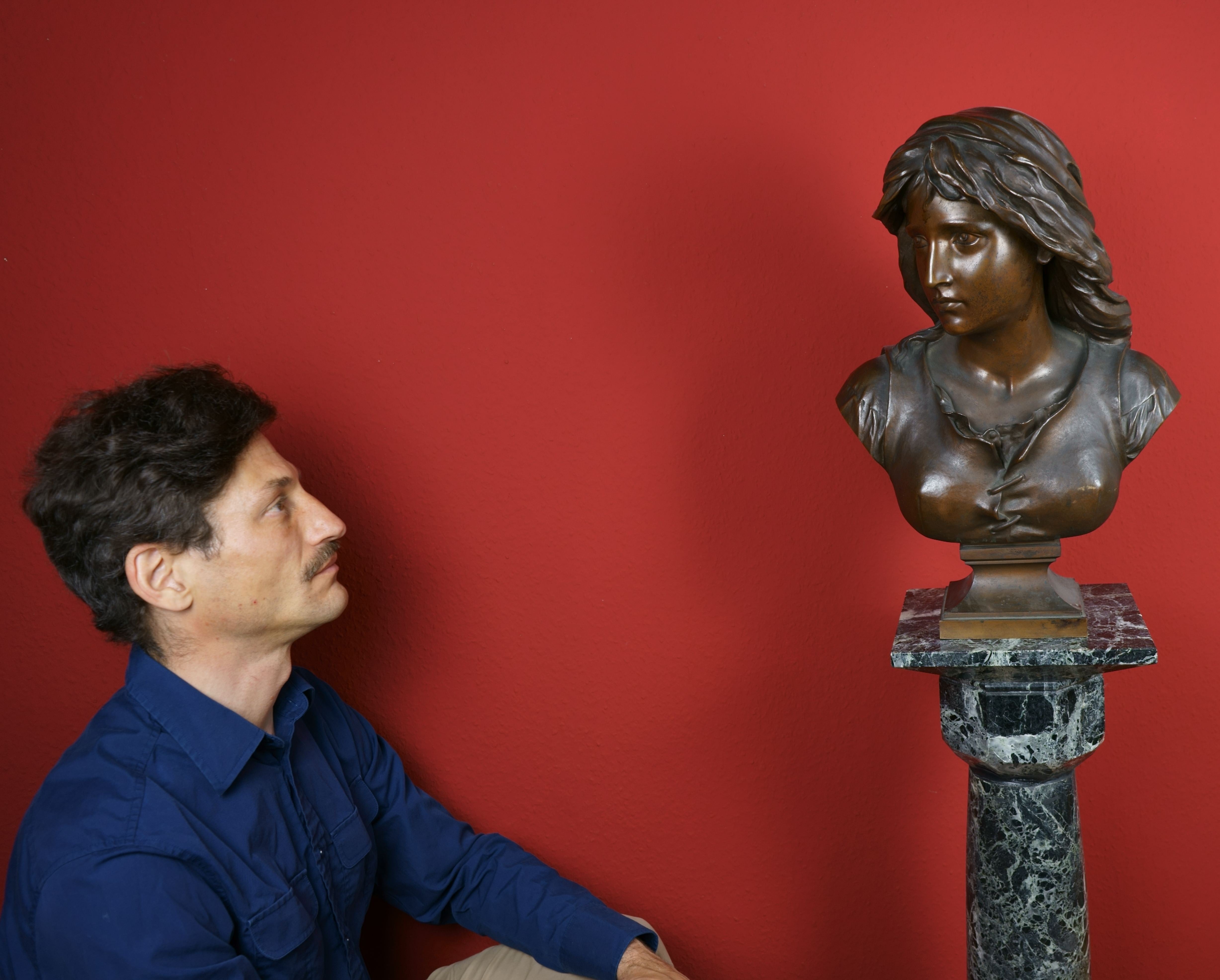
About the Seller
5.0
Gold Seller
Premium sellers maintaining a 4.3+ rating and 24-hour response times
Established in 2014
1stDibs seller since 2023
15 sales on 1stDibs
Typical response time: 4 hours
- ShippingRetrieving quote...Shipping from: Berlin, Germany
- Return Policy
Authenticity Guarantee
In the unlikely event there’s an issue with an item’s authenticity, contact us within 1 year for a full refund. DetailsMoney-Back Guarantee
If your item is not as described, is damaged in transit, or does not arrive, contact us within 7 days for a full refund. Details24-Hour Cancellation
You have a 24-hour grace period in which to reconsider your purchase, with no questions asked.Vetted Professional Sellers
Our world-class sellers must adhere to strict standards for service and quality, maintaining the integrity of our listings.Price-Match Guarantee
If you find that a seller listed the same item for a lower price elsewhere, we’ll match it.Trusted Global Delivery
Our best-in-class carrier network provides specialized shipping options worldwide, including custom delivery.More From This Seller
View AllVegetative Form / - Grown Art -
Located in Berlin, DE
Paul Dierkes (1907 Cloppenburg - 1968 Berlin), Vegetative Form. Mahogany, 1958. 142 x 16 x 10 cm (sculpture), 21 x 17.5 cm (base), monogrammed "PD" on the reverse.
- Grown Art -
...
Category
1950s Post-War Abstract Sculptures
Materials
Mahogany
Homage à Kahnweiler / - The Appearance of Genius-
Located in Berlin, DE
Irmgard Biernath (1905 Waldheim in Saxony - 1998 Mainz), Hommage à Kahnweiler, 1984. Terracotta relief, burnished red body, 43.5 x 38 cm, mounted on support plate, in wooden frame 57 x 49.5 cm, monogrammed "IB" at lower right.
- Isolated patina losses, but overall good condition, frame slightly bumped.
- The Appearance of Genius-
This homage to Daniel-Henry Kahnweiler shows the gallerist and art theorist as Pablo Picasso portrayed him in his lithographic portrait of 1957.
As an innovative Parisian gallery owner, Kahnweiler had exclusively represented Picasso since 1911, while Picasso had painted his famous portrait of Kahnweiler the previous year as a major work of Cubism. And it is Picasso who appears at the centre of Irmgard Biernath's image. Here, his face echoes the features of the self-portrait he painted in 1907 in the Prague National Gallery.
His eyes are wide open as he gazes into the distance, surrounded by the works of his artistic vision that have already taken shape. On the right is the bronze "Man with Sheep...
Category
1980s Contemporary Figurative Sculptures
Materials
Terracotta
Bust of a young woman / - Beauty of youth -
Located in Berlin, DE
Anonymous, Bust of a young woman, c. 1900, artificial marble and gray onyx marble. 37 cm (height) x 37 cm (width) x 22 cm (depth), weight 17.2 kg. Signed “GURRINI” on the reverse.
-...
Category
Early 1900s Realist Figurative Sculptures
Materials
Marble
Gradual Rotation / - Dynamic Tectonics -
Located in Berlin, DE
Thomas Röthel (*1969 Ansbach), Gradual Rotation, around 2005. Steel with rust patina mounted on stone plate. Overall dimensions: 38 cm (height) x 34 cm (width) x 27 cm (depth), weigh...
Category
Early 2000s Abstract Abstract Sculptures
Materials
Steel
Spear Fighter / - The Fighter's Concentration -
Located in Berlin, DE
Ludwig Eisenberger (active in Berlin between 1895-1920), Spear Fighter, around 1910. Brown patinated bronze with residual gilding on a cast terrain plinth with marble base (8 cm high...
Category
1910s Realist Nude Sculptures
Materials
Bronze
Forest idyll / - Soulmate -
By Rudolf Kaesbach
Located in Berlin, DE
Rudolf Kaesbach (1873 Gladbach - 1955 Berlin), Forest idyll, around 1915. Bronze, gold and golden brown patina, with cast plinth, mounted on a marble base (5 cm high), total height 36 cm, dimensions of the bronze: 31 cm (height) x 17 cm (length) x 12 cm (width). Weight 4,6 kg, signed on the plinth "R.[udolf] KAESBACH".
- a few rubbed areas, overall in excellent condition for its age
- Soulmate -
The bronze sculpture depicts a young woman in an intimate exchange with a deer that accompanies her. The animal pauses to turn toward her, while the nude beauty slows her pace to look into the deer's eyes and tenderly caress it with her hand. The woman and the deer are in inner harmony. Even though her lips remain motionless, she speaks the language of the animal with which she is deeply connected.
The golden patina, which contrasts with the more naturalistic coloring of the deer, gives the young woman the appearance of a saint, even if she cannot be identified as such. At the same time, she evokes memories of Diana, the goddess of the hunt, or a nymph. But she lacks the ferocity. In her innocent naivety, she is more like a vestal virgin, who is not at home in the solitude of the forest. And yet, the young beauty, moving unclothed in the heart of nature, looks like a priestess with her hair tied up and a carefully carried bowl on her way to a sacred grove.
In order to open up the above-mentioned associations, Kaesbach deliberately designed the female figure in such a way that she cannot be identified as a specific person. He has created an allegory of natural femininity, characteristic of Art Nouveau, in which the deer is far more than a companion animal. It displays the same gracefulness as the young woman, and the inner resemblance between the two makes the deer appear as her other self. In animal terms, it embodies her inner being, which also gives the deer an allegorical character.
About the artist
Rudolf Kaesbach studied sculpture at the Hanau Academy and worked in a bronze foundry in Paris in 1900. In order to work as an independent artist, he opened a workshop in Düsseldorf, where he cast bronzes from models he designed. In 1902 he made his debut at the German National Art Exhibition in Düsseldorf. The following year Kaesbach went to the academy in Brussels. There he was inspired by contemporary Belgian sculpture, especially the work of Constantin Meunier. He moved to Berlin, where he opened a studio in the villa district of Grunewald and devoted himself to life-size marble sculptures and the design of bronzes. From 1911, he regularly presented his works at the major art exhibitions in Berlin, as well as in Düsseldorf and Malmö. Between 1936 and 1939, he also created models for the Rosenthal porcelain factory. From 1939 to 1944, Kaesbach was represented at the major German art exhibitions in Munich.
GERMAN VERSION
Rudolf Kaesbach (1873 Gladbach - 1955 Berlin), Waldidyll, um 1915. Gold und goldbraun patinierte Bronze mit gegossener Plinthe, auf einem Marmorsockel montiert (5 cm Höhe), Gesamthöhe 36 cm, Maße der Bronze: 31 cm (Höhe) x 17 cm (Länge) x 12 cm (Breite). Gewicht 4,6 kg, auf der Plinthe mit „R.[udolf] KAESBACH“ signiert.
- vereinzele beriebene Stellen, insgesamt in einem altersgemäß ausgezeichneten Zustand
- Seelenverwandtschaft -
Die Bronzeplastik veranschaulicht eine junge Frau im innigen Austausch mit einem sie begleitenden Reh. Das Tier hält inne, um sich zu ihr hochzuwenden, während die nackte Schönheit ihren Schritt verlangsamt, um dem Reh ebenfalls in die Augen zu schauen und es zärtlich mit der Hand zu liebkosen. Die Frau und das Reh sind in einem inneren Gleichklang. Auch wenn ihre Lippen unbewegt bleiben, spricht sie die Sprache des Tieres, mit dem sie auf eine tief empfundene Weise verbunden ist.
Die im Kontrast zur naturalistischeren Einfärbung des Rehs aufstrahlende goldfarbene Patina lässt die junge Frau wie eine Heilige erscheinen, auch wenn sich nicht als Heilige identifizierbar ist. Zugleich ruft sie Erinnerungen an die Jagdgöttin Diana oder eine Nymphe hervor. Dafür fehlt ihr allerdings die Wildheit. In ihrer unschuldigen Naivität gemahnt sie vielmehr an eine Vestalin, die freilich nicht in der Waldeinsamkeit zu Hause ist. Und doch wirkt die sich unbekleidet im Herzen der Natur bewegende junge Schönheit wie eine Priesterin, die sich mit hochgebundenem Haar und der vorsichtig getragenen Schale und dem Wege zu einem Heiligen Hain befindet.
Um die gennannten Assoziationen zu eröffnen, hat Kaesbach die Frauenfigur bewusst so gestaltet, dass sie nicht als konkrete Person identifizierbar ist. Damit hat er eine für den Jugendstil charakteristische Allegorie natürlicher Weiblichkeit geschaffen, bei der das Reh weit mehr als ein Begleittier ist. Es weist dieselbe grazile Anmut wie die junge Frau auf und der innere Gleichklag der beiden lässt das Reh als ihr anderen Ich erscheinen. Es verkörpert – ins Animalische übertragen - ihr inneres Wesen, wodurch auch dem Reh ein allegorischer Charakter zukommt.
zum Künstler
Rudolf Kaesbach studierte an der Akademie Hanau Bildhauerei und war im Jahr 1900 in einer Pariser Bronzegießerei tätig. Um sich als eigenständiger Künstler betätigen zu können, eröffnete er in Düsseldorf eine Werkstatt, in der er Bronzen nach selbstentworfenen Modellen goss. 1902 debütierte er auf der Deutschen Nationalen Kunstaustellung in Düsseldorf. Im Folgejahr ging Kaesbach an die Akademie nach Brüssel. Dort wurde er von der zeitgenössischen belgischen Bildhauerei, insbesondere vom Werk Constantin Meuniers, inspiriert. Zurückgekehrt zog er nach Berlin, wo er im Villenviertel Grunewald ein Atelier eröffnete und sich neben dem Entwurf für Bronzen der lebensgroßen Marmorbildhauerei widmete. Ab 1911 präsentierte er seine Werke regelmäßig auf den Großen Berliner Kunstausstellungen, aber auch in Düsseldorf und Malmö. Zwischen 1936 und 1939 fertigte er zudem Modelle für die Porzellan-Manufaktur Rosenthal an. Von 1939 bis 1944 war...
Category
1910s Jugendstil Nude Sculptures
Materials
Bronze
You May Also Like
Visage, Picasso, 1950's, Unique work, sculpture, design, Frame, Portrait
By Pablo Picasso
Located in Geneva, CH
Visage, Picasso, 1950's, Unique work, sculpture, design, Frame, Portrait
Visage
Unique work
1957
Painted and partially glazed ceramic ; tomette
16.9 x 15.2 cm
Certificate of authent...
Category
1950s Post-War Figurative Sculptures
Materials
Ceramic
Tête de faune, Picasso, Tile, Ceramic, Sculpture, Design, Postwar, Mythological
By Pablo Picasso
Located in Geneva, CH
Tête de faune, Picasso, Tile,Ceramic,Sculpture, Design, Postwar, Mythological
Tête de faune
Unique work
circa 1968
Painted and partially glazed ceramic, square tile
15.2 x 15.2 cm
C...
Category
1960s Post-War Figurative Sculptures
Materials
Earthenware
Petit masque central, Pablo Picasso, 1960's, Unique, Design, Plate, Theater
By Pablo Picasso
Located in Geneva, CH
Petit masque central, Pablo Picasso, 1960's, Unique, Design, Plate, Theater
Petit masque central
Unique work
16.5.63
Painted and partially glazed ceramic
D. 25.4 cm / 9.8 in.
D. 33 ...
Category
1960s Post-War Abstract Sculptures
Materials
Ceramic, Earthenware
Untitled #10 Female antique Bust painted and adorned. Infortunios De La Virtud
By Armando de la Garza
Located in Miami Beach, FL
Untitled #10 (female bust), 2016
from Los Infortunios De La Virtud series
Antique porcelain bust with the intervention of oil, gold, silver, lea...
Category
Mid-19th Century Romantic Figurative Sculptures
Materials
Stone, Gold
Modern Beach Sculpture Ideal For Walls Abstract School of Fish Formations
By Arozarena De La Fuente
Located in Mexico City, MX
This hand made art work is a modular and comes with 20 fish sculptures all in four different sand tones (five of each). These abstract fish project shadows on the wall turning light into an essential component for double sculpture...
Category
2010s Abstract Figurative Sculptures
Materials
Sandstone
Venus, Modern Abstract Figurative Sculpture #37
By Doris Warner
Located in Soquel, CA
Wonderful small scale abstract figurative stone Venus sculpture by Doris Ann Warner (American, 1925-2010), 1975. A highly abstracted female form is expressed through the organic, fl...
Category
1970s Modern Figurative Sculptures
Materials
Sandstone
$2,120 Sale Price
41% Off

